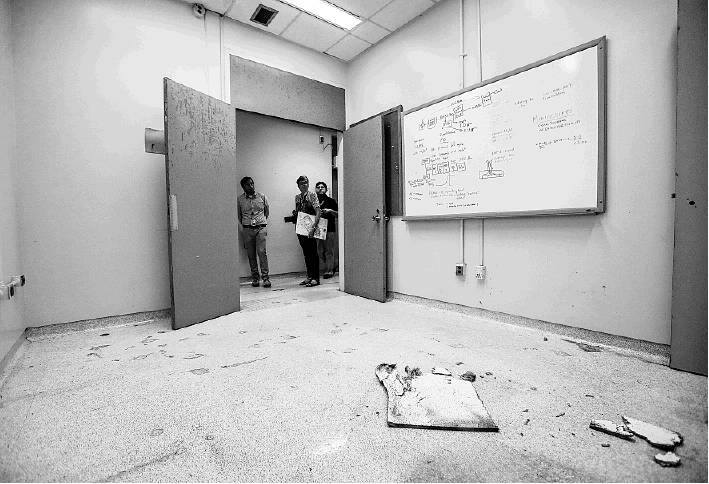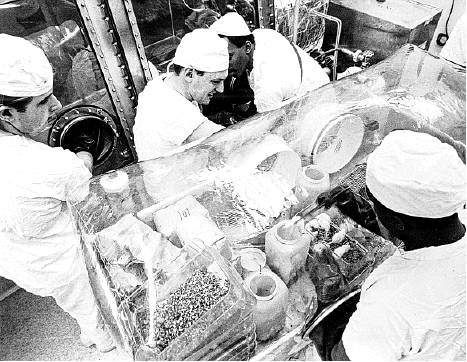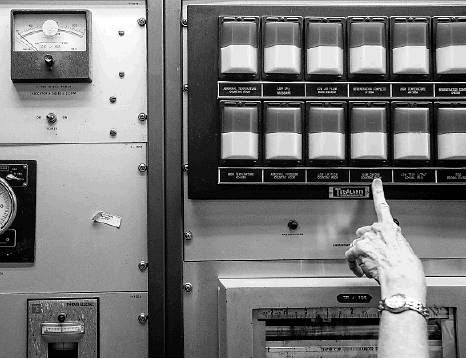Building used for Apollo 11’s quarantine set for demolition
NASA to tear down facility where astronauts lived, worked for 3 weeks after moon mission
By Alex Stuckey STAFF WRITER
First moon-walker Neil Armstrong stood behind a candle-topped, white-frosted cake on Aug. 5, 1969, surrounded on his 39th birthday not by family but by a group of men clad in white scrubs.
His wife, Janet, was there, of course, but she was forced to stand on the other side of a thick wall of glass — a precaution taken by NASA in the weeks after the Apollo 11 astronauts returned from the moon.
Unsure of what infectious diseases the astronauts might bring back to Earth, NASA quarantined them for three weeks, building a state-of-the-art facility at Johnson Space Center in Houston where they could live and work until scientists were satisfied it was safe.
The building, nestled in an eastern corner of the center’s campus, is where NASA began studying its first set of lunar rocks; where the Apollo 11 capsule was brought after splashing down in the Pacific Ocean; where the astronauts first emerged from quarantine to speak to the world.
But 50 years later, NASA has decided to tear down the building, known as the Lunar Receiving Laboratory. This is likely to happen in early 2020.
“I just hate to see what this building represents and what we did here 50 years ago go away,” said Judy Allton, a curator at Johnson.
The facility has fallen into severe disrepair.
Exposed wires snake down from ceiling tiles saturated with mold, their ends spiraling along the ground next to fallen bits of fiberglass, discarded office supplies and, inexplicably, leaves that rustle underfoot.
The room where Armstrong cut his birthday cake is covered floor to ceiling in unidentifiable stains; his living quarters are infested with mold. Half the lights are inoperable, plunging parts of the building into darkness.
In the years after the Apollo program, the building housed astronaut health projects. But about a decade ago, NASA officials began to discuss tearing down the lab — opting to construct a new, energy-efficient building to replace it.
A preliminary engineering report conducted by aDallas-based firm, HDR Architecture, between 2010 and 2011 sealed the historic laboratory’s fate. The building, the report said, was deteriorating and not up to code.
A year after the report was completed, that same company won the $5.7 million contract to design its replacement.
Dennis Patrick, HDR project manager for the new building, told the Houston Chronicle that the two contracts don’t represent a conflict of interest.
“It’s a 50-year-old building. It’s an energy nightmare,” Patrick said. “The facts are the facts. Pointing out something that simple is very shallow and assumptive. It doesn’t exhibit a deep grasp of the facts involved.”
NASA officials, too, said they saw nothing wrong with HDR being awarded the design contract for a building it concluded should replace the lab. The agency already knew that fixing the lab would be complicated and expensive, the officials said.
“Just because (HDR) got the contract to do the (engineering report) doesn’t mean they were going to get the design contract,” said Charles Noel, chief of the planning and integration office at Johnson. “Whoever was in the bidding process, they could have picked another contractor.”
Now, just months after the nation celebrated the 50th anniversary of Apollo 11, historians find themselves at aloss. After fighting to save the building — the second most historic on campus, behind the Apollo Mission Control room — for five years, they have resigned themselves to losing it.
So to honor its legacy, they plan to build an interpretative park that will salvage some equipment from the building to help tell the story of what happened there.
“I’m fully in support of this park,” said Sandra Tetley, Johnson’s historic preservation officer. “But its a shame to lose the building.”
Too expensive to maintain
The Lunar Receiving Lab, completed in 1967, was designed to isolate the astronauts and the rock samples returning from the moon. A number of scientists were fearful that astronauts would return with infectious diseases.
“Since no one had ever been to the Moon, it was impossible to be absolutely sure that there were no biological threats to life on Earth,” according to aJune 2004 NASA publication detailing the lab’s history. “Many space experts argued that conditions on the Moon made it impossible for any life form to survive, but these agencies felt that even the smallest risk of back contamination must be prevented.”
Scientists soon learned that the astronauts returned uncontaminated, and quarantine requirements were lifted after the Apollo 14 mission in 1971. Since that time, the building has been repurposed for projects primarily focused on astronaut health.
As the building aged, however, questions about its continued utility began to surface. Specifically, NASA officials began questioning the integrity of the foundation.
So in 2010, NASA awarded HDR a $1.3 million, nine-month contract to assess the building’s conditions. NASA officials did not provide a copy of that report but said it did not examine the cost of saving the building. Instead, it determined what personnel who used the building needed.
Some of those findings were detailed in a fiscal year 2015 economic analysis provided to the Chronicle. HDR determined, for example, that the HVAC system would need to be replaced, the structural slab deficiencies addressed and the electrical systems upgraded.
The findings were what NASA expected, said Joel Walker, director of center operations at Johnson.
“Short of some miracle happening …we knew it was really not feasible or practical for us to save it,” Walker said. “It had no current use.”
NASA moved forward, and rules regarding the agency’s spending required it to remove square footage in order to build more.
In June 2012, a year after HDR’s contract to assess the building ended, the firm was awarded a $5.7 million, five-year contract to design the new building. It is the biggest contract the company has received from NASA since 2008, according to USAspending.gov.
An economic analysis for fiscal year 2015 determined it would cost $82 million to renovate the lab, compared with $53.5 million to build a new one. Noel believes this analysis was conducted by an on-site contractor.
‘Hard decisions’
The treatment of the Lunar Receiving Lab stands in contrast to that of the Apollo Mission Control room, which was fully restored in July after Space Center Houston, Johnson’s visitor center, and the city of Webster teamed up to raise the $5 million needed to save it.
The lab is different, in part, because it is a complete building, not just a couple of rooms. Mission Control also was listed on the National Register of Historic Places in 1985. The Lunar Receiving Lab was never listed, even though it is eligible, Tetley said.
Mission Control also had the backing of Apollo legends such as Apollo-era Mission Control Director Gene Kranz, who fought to raise money and get people involved to restore the room to its 1969 glory days. That’s how Space Center Houston got involved in fundraising.
But that kind of support hasn’t emerged for the Lunar Receiving Lab. Space Center Houston has not been presented with an opportunity to preserve the lab and officials don’t plan to request such a mission, said Meridyth Moore, spokeswoman for the visitor center.
Everett Gibson, an emeritus senior scientist at Johnson, worked in the lab during Apollo 12 through 17 missions. It’s hard to see the building go, he said, but saving it for historical purposes would be cost prohibitive. He’s also not sure the public interest is there.
“Sometimes in life we have to make hard decisions, and I don’t know what you could do with it,” he said. “It’s sitting out there rotting, and the cost to keep it going is just horrendous. I don’t think it’s that exciting to a man and a woman on the street.”
So Tetley is moving forward with the interpretative park, which she hopes will be accessible to visitors of Space Center Houston via tram tours. She plans to save the original stairs, pillars and walkways, in addition to as many pieces of equipment inside the building as she can
Though she hates to see the building go, there isn’t much she can do about it.
“They never intended to save the building,” Tetley said. alex.stuckey@chron.com twitter.com/alexdstuckey



